Now
Greg Martin
Liberty Wildlife Contributor
Consider the life of a Mayfly.
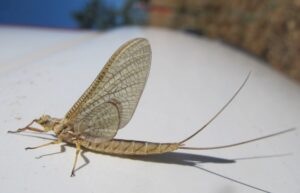 Count the hours in a single day. That’s the lifespan of one of these most insignificant creatures. You have to wonder: what is the point? What use does it have? What kind of purpose can it serve? What makes one day’s actions any more important than the next?
Count the hours in a single day. That’s the lifespan of one of these most insignificant creatures. You have to wonder: what is the point? What use does it have? What kind of purpose can it serve? What makes one day’s actions any more important than the next?
The answer is that those 24 hours are the most important of a Mayfly’s life, regardless of the fact that they’re the only hours of its life. The decisions each and every Mayfly makes determines whether their entire species will carry on. What they do ultimately affects, not only the future of Mayflies, but the fates of all those creatures that depend on them, which is a larger list than one might think.
On the geological timeline, we are all only Mayflies. From birth to death, humans tick but seconds off the clock for a planet spanning billions of years of existence. Yet our window of opportunity, however narrow, is more important than that of any creature that has ever walked the Earth. Each of us carries an unfathomable gravity of action as it pertains to the survival of our species and the health, or sickness, of our planet. That may be daunting, but it’s also doable. History is made by nations, but destiny dwells in little choices in the hands of individuals.
The Mayfly doesn’t have the luxury to ponder or postpone the act of preserving its species. For each and every Mayfly, the time is always now. There is no“later.”We’d do well to heed their sense of urgency, because from Australia to the Amazon, the world is burning down around us. Sobering estimates suggest that over one billion animals have perished in the Australian inferno thus far.[1]Consider that number. Not a thousand. Not a million. 1,000,000,000. A billion. One billion animals, from a country boasting some of the most unique, diverse, and beloved species on Earth, ceased to exist in the span of a few months. That’s beyond disaster. That’s cataclysm. And the fires burn on.
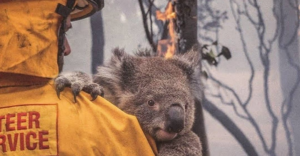 If there is ever a redeeming flicker in tragedy, it shines in those souls who rise to even the gravest occasions. Governments and corporations have resources to expend, but the countless people who volunteer what only they can give, whether in money, time, or expertise, are fostering something far greater than their heroism in the moment, even as they fight to save every Australian animal they can. Their rush to help is something we can all stand to learn from, and apply, in our daily lives. We desperately need to.
If there is ever a redeeming flicker in tragedy, it shines in those souls who rise to even the gravest occasions. Governments and corporations have resources to expend, but the countless people who volunteer what only they can give, whether in money, time, or expertise, are fostering something far greater than their heroism in the moment, even as they fight to save every Australian animal they can. Their rush to help is something we can all stand to learn from, and apply, in our daily lives. We desperately need to.
Small choices, for every animal and in all environments, make tiny differences. And tiny differences change everything. That’s where the future lives or dies. And that’s where the hope for a better, healthier, more sustainable world exists. With each of us.
Because the time is now. And later is too late.
[1]https://www.smithsonianmag.com/smart-news/more-one-billion-animals-have-been-killed-australias-wildfires-scientist-estimates-180973926/
Across Time
Gail Cochrane
Liberty Wildlife Volunteer
Any day I get out to hike is a cherry of a day. For me it isn’t about clocking miles, but more of a total immersion in the wild nature of it all. Today, I see and hear rock wrens and gnatcatchers, and fresh fat brittle bush leaves unfolding everywhere. Wandering through a cool and shaded canyon I touch boulders that still hold the measure of the day’s sunlight, and they feel warm, even alive beneath my fingers.
If it’s a perfect day, I have time to sit awhile in a lonely wash and wait for visitors, perhaps a coyote on patrol, or a covey of quail clucking madly as they come single file over the ridge. Even thin skeins of clouds crossing the blue overhead are worthy of lengthy consideration, as they take me away from my normal day to day thoughts. These interactions with the wild world feed my soul, and they have the capacity to absorb my frustrations, my pettiness, my pain.
Imagine the close connections that our ancient ancestors enjoyed with the natural world! For them this desert was the ultimate home and provider. We understand that Indigenous peoples considered the natural Earth to be sacred, and that they made use of plants, animals, stones and night skies for their very survival. Everyone was consumed with their time intensive tasks as there were no short cuts, no conveniences. Yet these people didn’t have to escape their normal world to find connection to the sublime, they were already there.
Now we are masters of convenience. No chewing yucca to make twine for us. But what price do we pay when we sever ties with our natural world? We surely lose something in the way of ingrained internal compass and coping mechanisms when we detach from our relationship with Earth to rely instead on our material possessions and our technologies. Could this be the cause of our modern malaise?
And I must wonder about my descendants, and what relations they will have with the Earth. Will there even be wild lands still waiting for them? Because, truth be told, the “wilderness” where I wander is a city park…a desert preserve on the edge of one of the nation’s largest cities. My closest go-to nature getaway is just a single canyon. This space where I wander today has escaped suburban development because it channels water during big rains and the stony sides are too steep for building. Yet this corner of nature has the capacity to feed my soul. These areas where I hike still support populations of birds and reptiles, wild plants, insects, and transient mammals.
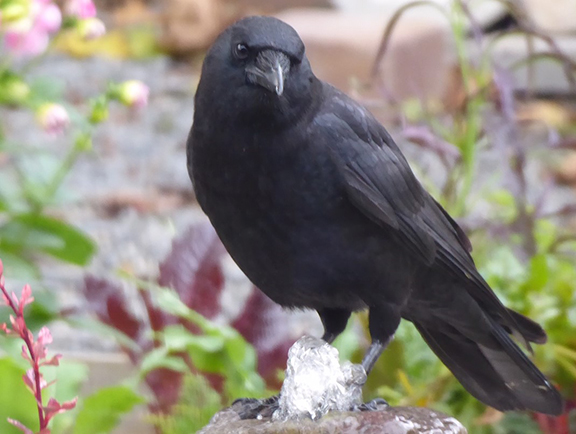 It seems that plenty of people understand the importance of human relationships with nature. The knowledge so elegantly illustrated in interwoven biological communities is hard to overlook. As is the fact that humans are essentially just one of the strands. I believe that future children will thrill to discovery in nature camps and that dedicated adults will volunteer to take coteries of youngsters on overnight camping and star gazing missions. I believe volunteers will come out to rescue and heal wild animals and that generous benefactors will support this work.
It seems that plenty of people understand the importance of human relationships with nature. The knowledge so elegantly illustrated in interwoven biological communities is hard to overlook. As is the fact that humans are essentially just one of the strands. I believe that future children will thrill to discovery in nature camps and that dedicated adults will volunteer to take coteries of youngsters on overnight camping and star gazing missions. I believe volunteers will come out to rescue and heal wild animals and that generous benefactors will support this work.
When I think of my grandchildren’s grandchildren, I wish for them a relationship that keeps a pulse on the cycles of life and nature, and that keeps an awareness of the wild world as close as modern kids keep their cell phones. For them, technology could be the fun thing they get away to, every now and then.
Arizona Native Owl Hunting Techniques
Claudia Kirscher
Liberty Wildlife Volunteer
Owls, like other birds of prey have a variety of adaptive hunting techniques and styles. Owls overall have evolved heightened senses to hear or spot their prey.
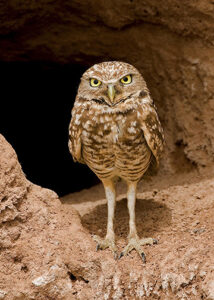 The Burrowing Owl is our only owl that lives in underground burrows they have taken over from other animals such as prairie dogs and squirrels, though they can dig or enlarge these on their own. They are primarily daytime hunters having developed long legs enabling them to sprint across open grasslands in pursuit of insects and small rodents. They will also fly after prey.
The Burrowing Owl is our only owl that lives in underground burrows they have taken over from other animals such as prairie dogs and squirrels, though they can dig or enlarge these on their own. They are primarily daytime hunters having developed long legs enabling them to sprint across open grasslands in pursuit of insects and small rodents. They will also fly after prey.
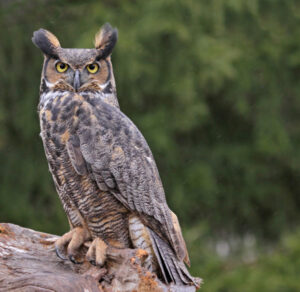 The Great-horned Owl is a powerful predator that can take a variety of prey, even larger than they are such as skunks, rabbits, or young nestlings of red-tail hawks or eagles. These owls perch and wait, listening and watching for their next meal. They have a facial disc of feathers that, much like the Harrier, funnel sounds to their highly sensitive ears. Their overly large eyes have a high number of cones and rods enabling them to see well in the dark. They have short wide wings for maneuverability in wooded areas. Their feathers are soft, enabling silent flight. They hunt primarily dusk and dawn, but will hunt all night long if needed.
The Great-horned Owl is a powerful predator that can take a variety of prey, even larger than they are such as skunks, rabbits, or young nestlings of red-tail hawks or eagles. These owls perch and wait, listening and watching for their next meal. They have a facial disc of feathers that, much like the Harrier, funnel sounds to their highly sensitive ears. Their overly large eyes have a high number of cones and rods enabling them to see well in the dark. They have short wide wings for maneuverability in wooded areas. Their feathers are soft, enabling silent flight. They hunt primarily dusk and dawn, but will hunt all night long if needed.
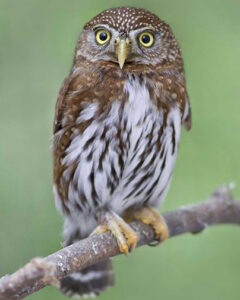 The Northern Pygmy-Owl hunts during dawn, dusk, and occasionally daytime. They are a perch and pounce predator surprising small to medium size birds such as waxwings and chickadees, mice, beetles, moths and small reptiles. They will also raid nests of songbirds and woodpeckers. A powerful little package weighing only 2.5 grams! They favor coniferous and deciduous forests, but will come down to lower desert and urban elevations during cold winter temperatures. They will sometimes hunt birdfeeders.
The Northern Pygmy-Owl hunts during dawn, dusk, and occasionally daytime. They are a perch and pounce predator surprising small to medium size birds such as waxwings and chickadees, mice, beetles, moths and small reptiles. They will also raid nests of songbirds and woodpeckers. A powerful little package weighing only 2.5 grams! They favor coniferous and deciduous forests, but will come down to lower desert and urban elevations during cold winter temperatures. They will sometimes hunt birdfeeders.
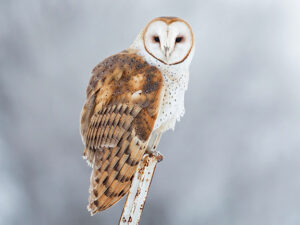 Barn Owls are strictly nighttime hunters relying on their highly sensitive hearing as well as sharp eyesight. They also have a facial disc of feathers that funnel sound to ears on the side of their head. They hunt mainly mice and rats. They have unusually soft feathers, aiding in silent flight. They soar, glide back and forth, and pounce on prey while hunting, preferring large open grassland or agricultural fields.
Barn Owls are strictly nighttime hunters relying on their highly sensitive hearing as well as sharp eyesight. They also have a facial disc of feathers that funnel sound to ears on the side of their head. They hunt mainly mice and rats. They have unusually soft feathers, aiding in silent flight. They soar, glide back and forth, and pounce on prey while hunting, preferring large open grassland or agricultural fields.
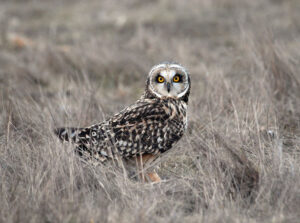 The Short-eared Owl hunts during the day. It flies low over grasslands, coursing back and forth, using sharp eyesight and acute hearing. It too has a facial disc that funnels sound into its ears. They prey on small mammals such as mice, pocket gophers, bats as well as birds. Its short stubby ear tufts are rarely seen. They are a migratory owl, moving from colder climates in winter to areas with more abundant prey.
The Short-eared Owl hunts during the day. It flies low over grasslands, coursing back and forth, using sharp eyesight and acute hearing. It too has a facial disc that funnels sound into its ears. They prey on small mammals such as mice, pocket gophers, bats as well as birds. Its short stubby ear tufts are rarely seen. They are a migratory owl, moving from colder climates in winter to areas with more abundant prey.
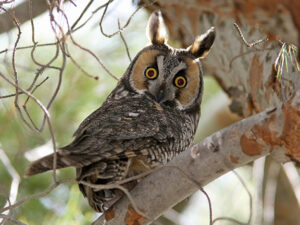 Another winter migratory owl is the Long-eared Owl. It hunts only at night over open grasslands, able to find prey in complete darkness due to its sensitive hearing. Like the Great-horned Owl it hunts a large variety of prey including mice, rats, gophers, bunnies, small birds, small snakes and insects. During the daytime, they roost in dense foliage, occasionally in a group of other migratory Long-eared Owls, one of the only owls to do this.
Another winter migratory owl is the Long-eared Owl. It hunts only at night over open grasslands, able to find prey in complete darkness due to its sensitive hearing. Like the Great-horned Owl it hunts a large variety of prey including mice, rats, gophers, bunnies, small birds, small snakes and insects. During the daytime, they roost in dense foliage, occasionally in a group of other migratory Long-eared Owls, one of the only owls to do this.
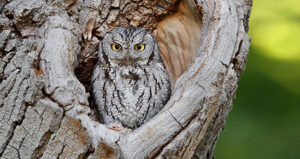 The Western Screech Owl is a nocturnal hunter, taking a variety of prey including small mammals, small birds and insects. Prey depends on the season and what is available. It is a sit and surprise pounce hunter but will often engage in flycatcher-like hunting for insects. They sometimes hunt insects at porch and street lights. They roost and nest in cavities in trees, saguaros, and will even take to nest boxes.
The Western Screech Owl is a nocturnal hunter, taking a variety of prey including small mammals, small birds and insects. Prey depends on the season and what is available. It is a sit and surprise pounce hunter but will often engage in flycatcher-like hunting for insects. They sometimes hunt insects at porch and street lights. They roost and nest in cavities in trees, saguaros, and will even take to nest boxes.
Resources: Allaboutbirds.org, Audubon.org, Wikipedia.
Kid Stuff
Carol Suits
Nurturing Nature

Owls! Owls! Owls! Owls!
There are 19 different kinds or species of owls in North America. Those that are native to Arizona are the barn owl, western screech owl, great horned owl, Mexican spotted owl, elf owl, northern pygmy owl burrowing owl and the northern saw-whet owl. They mostly feed on small mammals such as mice, squirrels, rabbits and skunks. But some also eat insects, spiders, frogs and lizards.
Watch this video about owls.https://www.youtube.com/watch?v=m0XgSrdYQRY
What do you know about owl pellets? Check this out! https://www.birdnote.org/show/examining-owl-pellets
Great horned owls start nesting in the winter. If you listen at night, you may hear them calling each other. https://www.birdnote.org/show/great-horned-owl-duet
Draw a great horned owl. The first link is an easy owl to draw while other one is the owl looking back at you.
https://www.youtube.com/watch?v=xUuWJFmI2hI
https://www.youtube.com/watch?v=JtMXImftPeA
Two owls are in pieces! Help!


